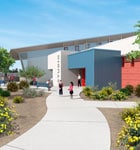Who: Marshall and Jeff Zotara have devoted the past 12 years to uniting corporations with local communities. Based in Carlsbad, California, the father and son operate Cause and Effect Evolutions, a cause-development firm that helps organize corporate projects benefiting the underprivileged.
“[Those in] corporate America are our neighbors,” says Jeff Zotara, Marshall’s son. “They’re people, not just entities. When we started Cause and Effect, we wanted to engage the employees of corporate America, because there’s often this yearning for corporations to do more in their local communities. So our primary focus has been to be the puzzle-masters who help coordinate community-building activities like home or school makeovers.” Most recently, the Zotaras have zeroed in on a shocking and overwhelming need for updates to school campuses. They’re calling the project the Green Schoolhouse Series.
Green School Series
launched
2008
location
Nationwide
distinction
Creating entirely donated “21st-century learning environments” designed to LEED Platinum standards
website
greenschoolhouseseries.org
What: Instead of trucking in prefabricated classroom units, Cause and Effect is doing the exact opposite. Partnering with architects who are local to each school district, the firm is coming up with uniquely designed campuses that emphasize sustainability and new learning practices.
“This is going to be an iconic new example of what’s possible,” Jeff says proudly, pointing to the structures’ new technologies, open floor plans, and multiuse spaces—all of which are designed to bring communities at large onto the campuses. “This is much different than what schools were 25 years ago. And most importantly, we want to influence the children, parents, and teachers to make behavioral changes.” Jeff presents a case study: Washington Elementary School District saved a chunk of change simply by changing the way it used energy: shutting of the lights, turning off the computers, and closing the doors. “They saved $2.5 million of good old American cash,” Jeff says, “just by modifying one thing.”
Cause and Effect has come up with three basic school models, ranging from 6,000 to 15,000 square feet: the Safari (for kindergarten through fifth grade, with a jungle theme), the Studio (sixth through eighth grade, with a performing-arts theme), and the Loft (ninth through twelfth grade, with an emphasis on green learning.) The models have certain common features, including community rooms, outdoor classrooms, computer labs, kitchens, lounges, and libraries.
One stunning element that will be incorporated into the schools is the Science, Technology, Engineering, and Math (STEM) program, which partners with leaders in each of those fields to show kids the future through the hard sciences. It’s in this setting that Jeff has seen eighth graders building robots from scratch. “I’m always astonished because back when I was in eighth grade, I was going to school and going home,” he says with a laugh. “These children are the future. These facilities are like a Formula One racecar: You don’t drive it at 70 miles an hour.”
When/Where: The first school in the series—the Roadrunner Elementary School—broke ground in the Washington Elementary School District in in Phoenix in November 2011. In 2012 another school will be built in California. In 2013 there are plans for six more campuses, and in 2015 Cause and Effect will be expanding to 18 other cities across the United States.
Why: Back in post-World War II America, the country had a population explosion on its hands. The so-called baby boomers needed to be educated, and the school system became strained. To alleviate the problem, administrators put up portable classroom units that were never meant to be permanent. But instead of being replaced after a few years, many of them were used for decades. “Some of these units are 35 years old,” Jeff says. “You can’t do much to repair them because they’re pretty much falling apart—unstable floors, poor air circulation, and in some cases toxic environments.”
How: Perhaps the most remarkable part of the Green Schoolhouse Series is that the schools are completed entirely by volunteers. Cause and Effect coordinates with corporate entities (including DeVry University, Cisco Systems, and even NASA, among many others) to donate money, time, products, and strategies for the schools. Local architects contribute designs. Local contractors contribute labor. The school district isn’t required to pay a dime, and the schools go up within a four-month time frame and cost between $3 million and $6 million—all of which is donated. Each school is designed to be certified LEED Platinum.

